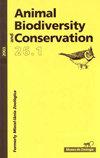濒临灭绝:越南特有小型虎壁虎种群现状及保护需求评估
IF 1
4区 环境科学与生态学
Q3 BIODIVERSITY CONSERVATION
引用次数: 2
摘要
人类影响被认为是全球生物多样性下降的主要威胁,尤其是对喀斯特生态系统中受威胁的特有物种。基于种群规模、密度和结构的时间和空间指标评估物种人口结构的研究有望评估威胁的影响程度,因此对物种保护工作越来越重要。火龙是越南的特有物种,是世界上最受威胁的爬行动物之一。由于栖息地的丧失和国际宠物贸易的过度开发,这种喀斯特适应物种被国际自然保护联盟红色名录列为极度濒危物种,并被列入《濒危野生动植物种国际贸易公约》附录二。在这里,我们提供了第一次评估G.huuliensis的种群状况。我们采用“捕获标记-再捕获”方法来估计种群规模,并确定种群密度和结构。据估计,总种群规模最多包括1447个位于综合适宜栖息地的个体,在总发生范围内,可能达到2855个仅位于喀斯特栖息地的个体。这远远低于最低存活人口的阈值。此外,据记载,胡氏G.huuliensis的平均种群密度极低,只有6.4个个体/km和2.5个个体/km/天。根据人口统计信息,持续的严重人类影响(如野生动物开采和石灰石开采)正将胡利虫推向灭绝的边缘。因此,迫切需要采取就地保护措施。我们建议应增加现场行动,并制定计划,为胡氏G.huuliensis建立一个物种和栖息地保护区。本文章由计算机程序翻译,如有差异,请以英文原文为准。
Living under the risk of extinction: population status and conservation needs assessment of a micro–endemic tiger gecko in Vietnam
Human impact is considered the major threat to the global decline of biodiversity, especially for threatened endemic species in karst ecosystems. Studies assessing a species' demography based on temporal and spatial indicators of population size, density and structure are expected to evaluate the level of impact of threats and are therefore becoming increasingly important for species conservation efforts. Goniurosaurus huuliensis, an endemic species in Vietnam, is one of the most threatened reptiles in the world. This karst–adapted species is classified by the IUCN Red List as Critically Endangered and listed under CITES Appendix II due to habitat loss and over–exploitation for the international pet trade. Here we provide the first evaluation of the population status of G. huuliensis. We applied a 'capture mark–recapture' method to estimate the population size and identify the population density and structure. The total population size was estimated to comprise a maximum of 1,447 individuals in integrated suitable habitats, possibly reaching up to 2,855 individuals exclusively in karst habitats within the total extension of occurrence. This is exceedingly lower than the threshold for a minimum viable population. Furthermore, G. huuliensis is documented to occur in extremely small mean population densities of only 6.4 indiv./km and 2.5 indiv./km/day along the surveyed transects. Based on the demographic information, the ongoing severe human impact (e.g. wildlife exploitation and limestone quarrying) is driving G. huuliensis to the brink of extinction. In situ conservation measures are therefore urgently required. We recommend that in-situ actions should be increased, and a plan should be developed to establish a species and habitat conservation area for G. huuliensis.
求助全文
通过发布文献求助,成功后即可免费获取论文全文。
去求助
来源期刊

Animal Biodiversity and Conservation
农林科学-动物学
CiteScore
2.00
自引率
0.00%
发文量
21
审稿时长
>12 weeks
期刊介绍:
Animal Biodiversity and Conservation (antes Miscel·lània Zoològica) es una revista interdisciplinar, publicada desde 1958 por el Museu de Ciències Naturals de Barcelona. Incluye artículos de investigación empírica y teórica en todas las áreas de la zoología (sistemática, taxonomía, morfología, biogeografía, ecología, etología, fisiología y genética) procedentes de todas las regiones del mundo. La revista presta especial interés a los estudios que planteen un problema nuevo o introduzcan un tema nuevo, con hipòtesis y prediccions claras, y a los trabajos que de una manera u otra tengan relevancia en la biología de la conservación. No se publicaran artículos puramente descriptivos, o artículos faunísticos o corológicos en los que se describa la distribución en el espacio o en el tiempo de los organismes zoológicos.
 求助内容:
求助内容: 应助结果提醒方式:
应助结果提醒方式:


